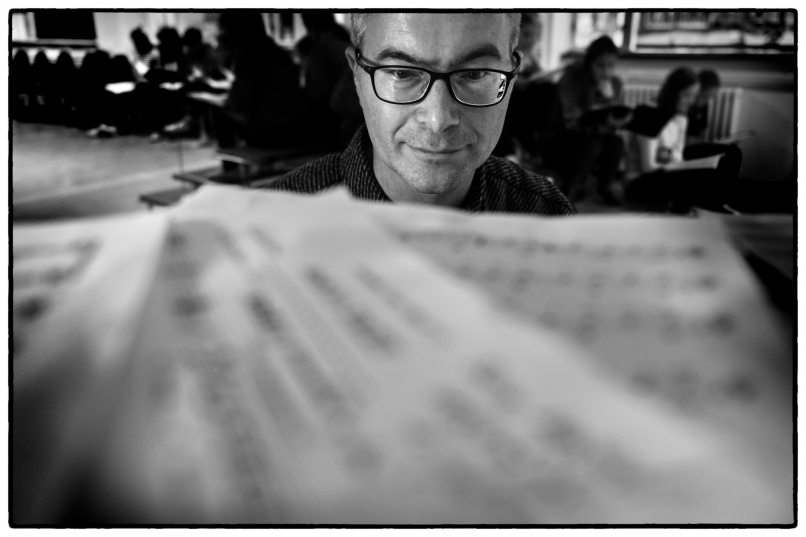piano:
| O VERSA | 1991 solo piano , 2cl , Bcl , 2hrn , 2 perc , 2vn , vla , vc , cb 12’30’’
percusssion
perc I: marimba A - c’’’’, wood blocks, finger cymbals, 3 temple blocks, tubular bells, Glockenspiel
perc II: Vibraphone f - f’’’, Wood block, Claves, Triangle, Tam-tam (medium), 1 crotale (C sharp’ ),3 tom toms, timpano (…inch)
comment
While composing A verso for piano I envisaged the possibility to pronounce and enlargen its structure in a work for piano and instruments. The following year this led to O versa for piano and 12 instruments. The first part is basically a transcription and orchestration of the solo piece, but before it is over the work takes a new direction, more typical of a concertino, and adds a series of “perorazio” to the original development of the compositional idea. The idea itself may be described as a study on repetition, on various levels of the structure, from the articulation down to the cell structure that makes up the sequences in the piano part, or to the right out repetion of one or more notes. All this probably stems from my interest in literary metrics with the relative formulas of rhytmic repetition and alliteration. The brief cadence was added only after the first performance. It takes off at a point where the material has been distilled and only pure “vapour” remains in the form of octave figures.
main performances
Reykjavík, February 16, 1992 (Íslenska Hljómsveitin, soloist: A.G. Gudmundsdottir)
Stavanger, October 27, 1993 (NMH Samtidsensemble, soloist: J.F Heyerdahl)
Stockholm, October 6, 1994 (Uppsala Chamber Soloists, soloist: Per Lundberg)
Milan, November 8, 1998 (Ensemble Nuove Sincronie, soloist: Kumi Uchimoto)
| ENVOI, FOR MIDIPIANO AND 19 INSTRUMENTS | 1995 solo Midipiano , fl , ob , cl , Bcl , bn , hrn , 2tpt , tbn , tba , 2 perc , harp , cel , 2vn , vla , vc , cb 14’
percussion
percussion I: marimba, 3 cencerros (g sharp, a, d’), temple block (g sharp), tubular bells, 3 tom-toms (high, medium, deep), snare drum, 2 gongs (A, c), 2 chinese cymbals (medium, large)
percussion II:, vibraphone, 2 tam-tams (small, large). 2 bell plates, timpano, gong (g sharp)
comment
Envoi was written on commission from IRCAM and Ensemble Intercontemporain in Paris. The Midipiano is a normal grand piano with a Midi-out device which captures the note pitches and intensities of what the pianist plays and provokes with that information various reactions of the computer. Much of the time the reactions of the computer are based on normal piano sounds which are in strict rhythmic and harmonic/contrapuntal relation to the real piano, in an attempt to create a sort of extended piano, which is mid-way between an expressive and mechanical instrument.
main performances
Paris, January (twice) and April (twice) 1995, Ensemble Intercontemporain, soloist: Dimitri Vassilakis
clarinet:
| DUE BAGATTELLE II | 1997 solo cl + 3 or more background instruments 7’
comment
Due Bagattelle for clarinet were composed in 1987. Each of them is based on a spectre of pitches which remains immobile through the whole movement, but moves around these pitches in a certain way. They have been performed in various places in the original version, but in 1997 I thought of adding slight external resonances to the solo part to mark the underlying pitch structure, also introducing some repetitions in the solo part.
For performers: There are various ways of realising the background parts, which are divided in three voices: vla. Vc. Pno. or vn. Vc. Vib (or guitar or harp or cymbalom) etc. A couple of instruments with sustained notes (strings) and at least one with plucked or stricken notes, and also with more than one instrument per voice.
main performances
Amsterdam, May 30, 1998 (Gino Sgroi/Zephyr Ensemble)
Montepulciano, July 1998 (Gaspare Tirincanti/Ensemble MusicAttuale)
Palermo, December 14 1998 (Gino Sgroi/Zephyr Ensemble): The Musica su più dimensioni Festival
Reggio Emilia: The Di Nuovo Musica Festival
Rome, June 17, 2000 (Gino Sgroi/Zephyr Ensemble)
| IS ANYBODY THERE? | 2004
Solo clarinet (bassett-clar. in A) and 15 strings (5 first violins, 4 second violins, 3 violas, 2 cellos, 1 bass) 12’
comment
Is Anybody There was commissioned by NOMUS for Staffan Mårtensson and premiered by him with the Musica Vitae ensemble from Växjö, Sweden. In this piece I tried to let the soloist tread a very narrow path between being individual and impersonal. He is indeed in a main role, but sometimes has a very mechanical part to interpret. Although the role is quite difficult, it is not “heroic”. I guess the main concept of this piece has to do with individuality and absence and as part of this the five first violins play most of the time with metal mutes, being alienated from their usual leading role.
Main performances
Växjö, Gothemburg, Helsingborg, November 2004,
Épinal, September 2009
percussion
one player: marimba (A-c), vibraphone, tubular bells (c, e flat, f),tam-tam (small)
violin:
| MESSAGGIO DAL VETRAIO | 2018 solo vn, fl, cl, perc, vla, vc, cb 10'
comment
Messaggio dal vetraio is scored for solo violin, two woodwinds, percussion and string trio. It is based on a pre-existing violin solo, Etching. This piece presents a very firm metric structure, it is almost constantly in 11/8 metre. The rhythm constantly plays around the same formula, which also generates the pitch material. The role of the flute and clarinet is mostly to create an echo of the solo part, the string trio plays out the harmonic consequences of the solo part and the percussion unifies all parts by underlining the metric structure.
main performances
Skálholt, July 7 and 8 2018 (Marco Fusi, Caput Ensemble)

